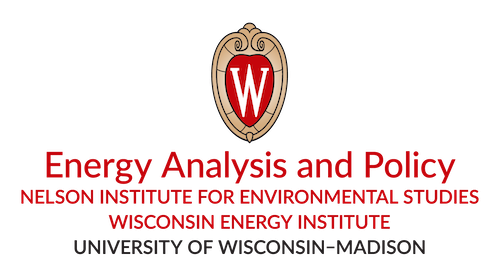
The Wisconsin Energy Institute is an ecosystem, a community of hundreds of students, scientists, faculty, and staff working on some of the world’s most pressing challenges in sustainable energy. It’s time for us to gather, to learn from each other, to catch up with existing connections, and perhaps meet a new collaborator or friend.
Join us on February 17th from 9:00am-11:45 pm at the Wisconsin Energy Institute for our inaugural Research Showcase. The Showcase will feature flash talks, posters, refreshments, and awards.
Agenda
- 9:00 am - Opening Remarks, Room 1115
- 9:15 am - 3 minute Flash Talks, Room 1115
- 10:15 am - Break
- 10:20 am - Poster Session and Reception, Atrium
- 11:30 am - Awards and Closing, Atrium
Presenters
Flash Talks
- Ahmed Hembel - Using 3D printing to make electric motors smaller
- Canan Sener - Linking Microbial Funneling to Hydrogenolysis-Based Lignin Depolymerization to Produce 2-Pyrone-4,6-Dicarboxylic Acid from Phenolic Monomers
- Rui Wang - Ammonia Recovery from Manure Wastewater and Simultaneous Electrosynthesis using Ammonium-Ion Selective Redox Material
- Mary Blanchard - Building a Bioeconomy Ecosystem
- Rebecca Alcock - Novel renewable energy networks for clinic and community resilience in resource-limited settings
- Jan Hellinger - The lignin of mulberry (Morus) trees are decorated with p-coumaric acid!
- Parisa Sarzaeim - CARE and FAIR Principles for Indigenous Water-Food-Energy Nexus Databases
- Eric Weeda - Taming Molecular Oxygen to Produce a Renewable Source of Bioderived Chemicals from Lignin
- Richard Hugh Connor Huntwork - Autoxidation Mechanisms and Methods for Plastics Upcycling
- Maitreyee Marathe - Optimal Energy Rationing for Prepaid Electricity Customers
- Derek Ho - The Glowing Potential of Nile Red for Microplastics Identifi-cation: Science and Mechanism of Fluorescence Staining
- Gonzalo Rodriguez Garcia - Direct air capture by mineral waste carbonation – Prospects and limits to embodied carbon in construction
- Patrick Sullivan - Grid Energy Storage: Why Battery Chemistry Matters
- Joshua Dietrich - Combinatorial library design for improving isobutanol production in Saccharomyces cerevisiae
- Josh Arnold - Badgervoltaics: Seeking Collaborators for Solar and Agriculture Pilot Project
- Erin Bulson - PFAS management for end-of-life vehicles: An energy perspective
- Ryan Dailey - Nuclear Reactors for District Energy Applications
- Aidan Rigby - Better Together: A Novel Concept for Renewable and Nuclear Energy Integration
Posters
- Ahmed Hembel - Using 3D printing to make electric motors smaller
- Canan Sener - Linking Microbial Funneling to Hydrogenolysis-Based Lignin Depolymerization to Produce 2-Pyrone-4,6-Dicarboxylic Acid from Phenolic Monomers
- Rui Wang - Ammonia Recovery from Manure Wastewater and Simultaneous Electrosynthesis using Ammonium-Ion Selective Redox Material
- Mary Blanchard - Building a Bioeonomy Ecosystem
- Rebecca Alcock - Novel renewable energy networks for clinic and community resilience in resource-limited settings
- Jan Hellinger - The lignin of mulberry (Morus) trees are decorated with p-coumaric acid!
- Josh Arnold - Badgervoltaics: Seeking Collaborators for Solar and Agriculture Pilot Project
- Matilyn Bindl - Consequences of Planning for High Adoption of Uncertain Carbon Dioxide Removal Technologies
- Henry Hundt - Navigating the Challenges of Renewable Energy Siting: A Tool for Community Engagement and Transparency
- Jiaqi Chen - Data-driven Piecewise Linearization for Three-Phase Power Flow in Distribution Grids
- Amy Enright - Systematic identification of genetic engineering targets for improved bioenergy stress tolerance in Zymomonas mobilis
- Jaime Garibay Rodriguez - Energy justice implications of transitioning to low-carbon systems
- Steve Karlen - Using the γ-valerolactone (GVL) biorefinery platform to fractionate biomass and microbial digestion to a portfolio of products
- Caryn S. Wadler - Engineering Streptomyces to Increase the Economic Viability of Lignocellulosic Biofuels
- Willa Mihalyi-Koch - Polar 2D Lead Iodide Perovskites Resulting from the Interplay of A-site and Asymmetric Spacer Cations
- Katelyn Michael - Using a Proton Selective Redox Reservoir for Flexible Pairing of Non-Aqueous and Aqueous Electrochemical Reactions
- Chris Holland - Integrating lignin depolymerization with aromatic product separations via centrifugal liquid chromatography
- Nick Mailloux - Avoided health-related costs from improved air quality under net-zero energy system pathways in the United States
- Michelle Chung - Communications: Sharing the Work and Stories of GLBRC and WEI
- Cullen S. Vens - Uncovering cell type-specific transcriptomes of Sorghum vasculature
- Linda Horianopoulos - Identification of yeasts with high glycolytic flux for the development of novel cell factories
- Matthew Nyberg - Spent Nuclear Fuel: Treasure from 100,000 Year Waste
- Jordi Francis Clar - Scaling up Lignin First Biomass Pretreatments
Thanks to our partner:

Date & Time
Location
Wisconsin Energy Institute1552 University Ave
Madison, WI 53726
